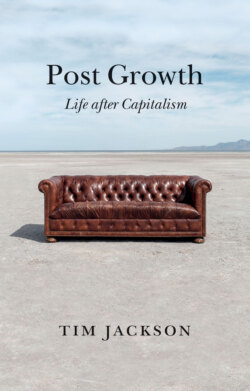Читать книгу Post Growth - Tim Jackson - Страница 23
Too big to fail
ОглавлениеA burst of ‘liquidity’ was just what the neoliberal economists had ordered. It worked after a fashion. Growth of a kind returned for a while. But its proceeds flowed predominantly to the rich. The reprieve – if it can be called as much – was short-lived. The 9/11 attacks in September 2001 threw another curve ball at the economy. Governments tried more of the same: more deregulation; more liquidity; and a whole new basket of complex financial instruments that no one – it turned out – really understood.21
The consequences were disastrous. Loose money and lax regulation ended up destabilizing financial markets. And they deepened social inequality. Protecting the interests of capital over the interests of workers inevitably favoured the rich over the poor. In a stunning reversal of almost fifty years of social progress, inequality within developed countries increased massively over the final decades of the twentieth century.22
The prescriptions for recovery had just made things worse. The early years of the twenty-first century turned into a ‘casino’ of speculative borrowing and lending. Households accumulated more and more debt. The conditions for chaos were mounting. All it took was a change in the rate of defaults on ‘subprime’ loans in the US housing market and in 2008 the bubble burst. The unintended consequence from half a century spent chasing after growth was the biggest crash since the 1930s.
‘The question arises,’ asked Summers in 2014, ‘can we identify any sustained stretch during which the economy grew satisfactorily with conditions that were financially sustainable?’ His answer, and the answer of an increasing number of other economists, was: no. Chasing growth through loose monetary policy in the face of challenging underlying fundamentals had led to financial bubbles which destabilized finance and culminated in crisis.23
Following the collapse of Lehman Brothers on 15 September 2008, western governments committed trillions of dollars to securitize risky assets, underwrite threatened savings, re-capitalize failing banks and re-stimulate the economy. No one pretended this was anything other than a short-term solution. Many even accepted that it was regressive: a temporary fix that rewarded those responsible for the crisis at the expense of the taxpayer. But it was excused on the grounds that the alternative was simply unthinkable. Collapse of the financial markets would have led to a massive and completely unpredictable global meltdown. Entire nations would have been bankrupted. Commerce would have failed en masse. The humanitarian costs of failing to save the banking system would have been enormous.
But government bailouts precipitated further crises. Country after country, particularly across the Eurozone, found themselves negotiating rising deficits, unwieldy sovereign debt and down-graded credit ratings. Austerity policies, brought in to control deficits and protect ratings, failed to solve the underlying issues. Worse, they created new social problems of their own. The withdrawal of social welfare compounded income inequality with something even worse: inequalities in healthcare, in longevity, in basic security, in human dignity. The injustice of bailing out the architects of the crisis at the expense of its victims became plain for all to see. ‘That’s your bloody GDP! It’s not ours!’24
Ironically, none of this achieved what it was supposed to achieve. Growth rates didn’t recover. Even before the Covid-19 lockdown, they were in a more or less steady decline. Austerity had left healthcare systems woefully unprepared for a global pandemic. Closing down economic activity was the only alternative. The chance of a smooth ‘recovery’ to the pre-crisis era remains slim. The likelihood of growth rates comparable with those in 1968, when Kennedy addressed the students in Kansas, remains virtually nonexistent. The conditions for wider social and political unrest remain palpable.
The most profound lesson from this very brief history is that the exact same policies designed to bring growth back were precisely the ones that led to its downfall. This seems to be the curious outcome from our crime scene investigation: capitalism’s downfall was the result of its own obsession with growth. Perhaps this is the point to examine that obsession further. And to understand why it exists in the first place.
